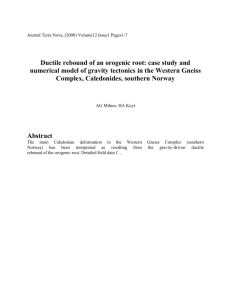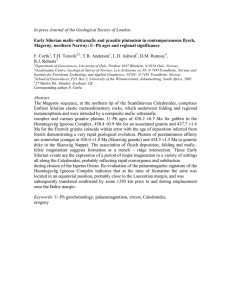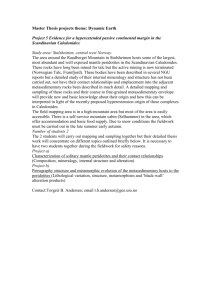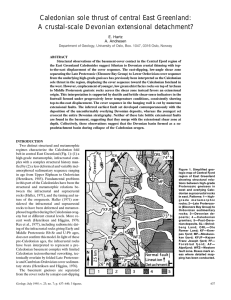We thank Rice (2001) for his comment on our paper... the opportunity to respond to points raised. Firstly, however, we...
advertisement
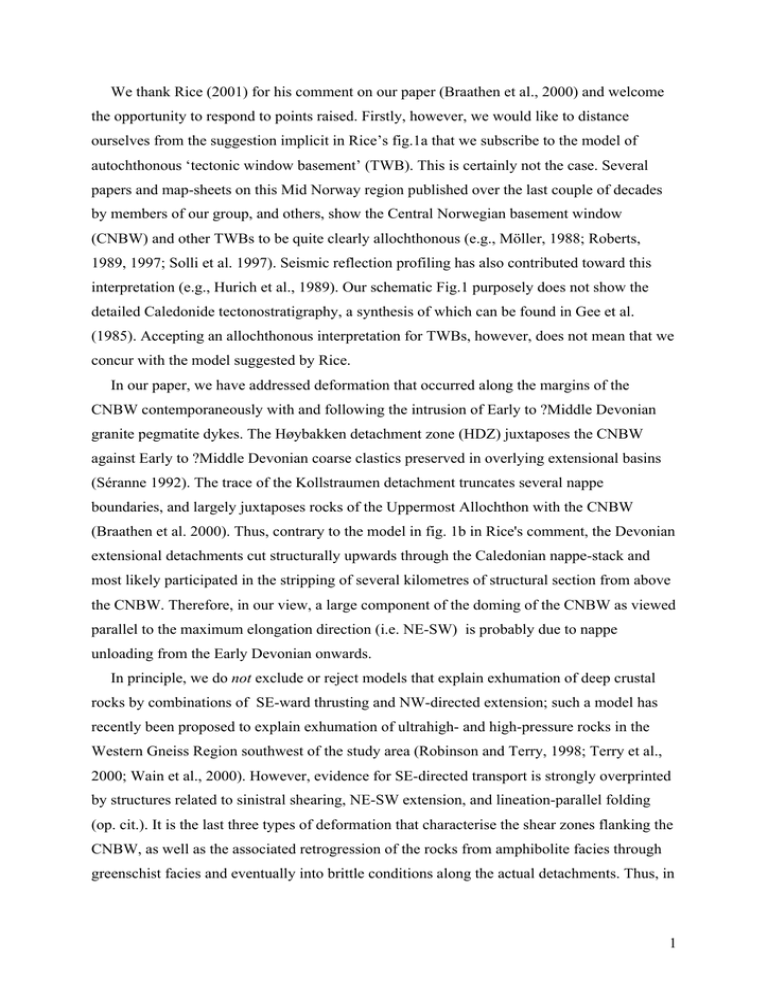
We thank Rice (2001) for his comment on our paper (Braathen et al., 2000) and welcome the opportunity to respond to points raised. Firstly, however, we would like to distance ourselves from the suggestion implicit in Rice’s fig.1a that we subscribe to the model of autochthonous ‘tectonic window basement’ (TWB). This is certainly not the case. Several papers and map-sheets on this Mid Norway region published over the last couple of decades by members of our group, and others, show the Central Norwegian basement window (CNBW) and other TWBs to be quite clearly allochthonous (e.g., Möller, 1988; Roberts, 1989, 1997; Solli et al. 1997). Seismic reflection profiling has also contributed toward this interpretation (e.g., Hurich et al., 1989). Our schematic Fig.1 purposely does not show the detailed Caledonide tectonostratigraphy, a synthesis of which can be found in Gee et al. (1985). Accepting an allochthonous interpretation for TWBs, however, does not mean that we concur with the model suggested by Rice. In our paper, we have addressed deformation that occurred along the margins of the CNBW contemporaneously with and following the intrusion of Early to ?Middle Devonian granite pegmatite dykes. The Høybakken detachment zone (HDZ) juxtaposes the CNBW against Early to ?Middle Devonian coarse clastics preserved in overlying extensional basins (Séranne 1992). The trace of the Kollstraumen detachment truncates several nappe boundaries, and largely juxtaposes rocks of the Uppermost Allochthon with the CNBW (Braathen et al. 2000). Thus, contrary to the model in fig. 1b in Rice's comment, the Devonian extensional detachments cut structurally upwards through the Caledonian nappe-stack and most likely participated in the stripping of several kilometres of structural section from above the CNBW. Therefore, in our view, a large component of the doming of the CNBW as viewed parallel to the maximum elongation direction (i.e. NE-SW) is probably due to nappe unloading from the Early Devonian onwards. In principle, we do not exclude or reject models that explain exhumation of deep crustal rocks by combinations of SE-ward thrusting and NW-directed extension; such a model has recently been proposed to explain exhumation of ultrahigh- and high-pressure rocks in the Western Gneiss Region southwest of the study area (Robinson and Terry, 1998; Terry et al., 2000; Wain et al., 2000). However, evidence for SE-directed transport is strongly overprinted by structures related to sinistral shearing, NE-SW extension, and lineation-parallel folding (op. cit.). It is the last three types of deformation that characterise the shear zones flanking the CNBW, as well as the associated retrogression of the rocks from amphibolite facies through greenschist facies and eventually into brittle conditions along the actual detachments. Thus, in 1 reporting on our studies of these shear zones, we have constrained ourselves to models that are supported by the field observations. Gneissic basement culminations (TWBs) are common features in the Scandinavian Caledonides (Sigmond et al., 1984; Roberts & Gee, 1985). Whereas some appear to preserve relatively unmodified, thrust-related geometries on both flanks, particularly those in eastern districts and in parts of N.Norway, others, such as the Mullfjället and Skardøra antiforms and the Rombak and Nasafjället windows, have been shown to be flanked by W-dipping extensional shear zones and faults (Sjöström et al., 1991; Rykkelid and Andresen, 1994; Andersen, 1998). These faults and shear zones are just as easily explained by post-doming extension as by a Chemenda et al.(1996)-type model, because they cut earlier, top-to-the-east shear zones and appear to be rooted in the basal Caledonian thrust, reactivating it as a top-tothe-west extensional detachment (see review in Andersen 1998). In westernmost districts of Central Norway, high-grade extensional fabrics have almost completely erased the original, thrust-related, top-SE, kinematic indicators in the mylonites flanking the TWBs (e.g., Roan window, CNBW). Thus, we maintain that culminations (TWBs) may have different origins or formed by a combination of mechanisms, depending on where the doming basement was located within the developing orogen (i.e., foreland contra hinterland), and also on the actual time of formation in the protracted strain history. It should be noted that we have not given any upper time constraint for the detachment faulting and associated flexural response. In Southwest Norway, parts of the Devonian Nordfjord-Sogn detachment zone, as well as the Lærdal-Gjende fault, were rejuvenated both in the Permian and in the Late Jurassic-Early Cretaceous (Torsvik et al. 1992, Eide et al. 1997, Osmundsen et al. 1998, Andersen et al. 1999). The geometry of the Western Gneiss Region in E-W section has been explained by isostatic uplift related to the Nordfjord-Sogn detachment in combination with hangingwall rotation upon the Lærdal-Gjende fault (Fossen 1992, Milnes et al. 1997). Doming of basement tracts like the WGR may thus have developed over a considerable period of time, irrespective of whether an allochthonous or an autochthonous interpretation is favoured. We do not perceive the linking of ductile sinistral movement along the Møre-Trøndelag Fault Complex (MTFC) with the top-WSW extensional shear on the HDZ as an anomaly. This pattern of Devonian sinistral shear is recorded widely in areas to the southwest of ours (Séranne, 1992; Robinson, 1995). Farther northeast, bulk lateral, sinistral offset along the multiply reactivated MTFC rapidly diminishes across the Grong-Olden culmination. There, 2 the fault also displaces the top-ENE shear fabrics on the eastward prolongation of the Kollstraumen detachment and disperses into a horsetail splay (Roberts, 1998). REFERENCES CITED Andersen, T.B., 1998, Extensional tectonics in the Caledonides of southern Norway, an overview: Tectonophysics, v. 285, p. 333-351. Braathen, A., Nordgulen, Ø., Osmundsen, P-T., Andersen, T.B., Solli, A., and Roberts, D., 2000, Devonian, orogen-parallel, opposed extension in the Central Norwegian Caledonides: Geology, v. 28, p. 615-618. Chemenda, A.I., Mattauer, M., and Bokun, A.N., 1996, Continental subduction and a mechanism for exhumation of high-pressure metamorphic rocks: new modelling and field data from Oman. Earth and Planetary Science Letters, v. 143, p. 173-182. Eide, E.A., Torsvik, T.H., and Andersen, T.B. 1997, Absolute dating of brittle fault movements: Late Permian and Late Jurassic fault breccias in western Norway, Terra Nova, v. 9, p. 135-139. Fossen, H, 1992, The role of extensional tectonics in the Caledonides of South Norway: Journal of Structural Geology, v.14, p. 1033-1046. Gee, D.G., Guezou, J.C., Roberts, D., and Wolff, F. C., 1985, The central-southern part of the Scandinavian Caledonides, in Gee, D.G. and Sturt, B. A., eds., The Caledonide orogen – Scandinavia and related areas: Chichester, UK, John Wiley & Sons Ltd., p. 109-133. Hurich, C. A., Palm, H, Dyrelius, D., and Kristoffersen, Y., 1989, Deformation of the Baltic continental crust during Caledonide intracontinental subduction: views from seismic reflection data: Geology, v. 17, p. 423-425. Milnes, A.G., Wennberg, O.P., Skår, Ø., and Koestler, A.G., 1997, Contraction, extension and timing in the South Norwegian Caledonides: the Sognefjord transect, in Burg, J-P. and Ford, M., eds., Orogeny through time: Geological Society of London Special Publication No. 121, p. 123-148. Möller, C., 1988, Geology and metamorphic evolution of the Roan area, Vestranden, Western Gneiss Region, Central Norwegian Caledonides, Norges geologiske undersøkelse Bulletin, v. 413, p. 1-31. Osmundsen, P.T., Faleide, J.I., and Andersen, T.B., 1998, Structural architecture of the SognNordfjord Region, western Norway: onshore-offshore tectonic links: Abstract volume, 23. Nordiske Geologisk Vintermøte, Århus 1998, p. 226. 3 Rice, A.H.N., 2001, Devonian, orogen-parallel, opposed extension in the Central Norwegian Caledonides: a comment, Geology Roberts, D., 1989, Tectonostratigraphy within the area of 1:250,000 map-sheet ‘Grong’, Nord-Trøndelag, Central Norway. Geologiska Föreningens i Stockholm Förhandlingar, v. 111, p. 404-407. Roberts, D., 1997, Geologisk kart over Norge. Berggrunnsgeologisk kart GRONG, M 1:250 000, Norges geologiske undersøkelse. Roberts, D., 1998, High-strain zones from meso- to macro-scale at different structural levels, Central Norwegian Caledonides: Journal of Structural Geology, v. 20, p. 111-119. Roberts, D., and Gee, D.G., 1985, An introduction to the structure of the Scandinavian Caledonides, in Gee, D.G., and Sturt, B.A., eds., The Caledonide orogen – Scandinavia and related areas: Chichester, UK, John Wiley & Sons, Ltd., p. 55-68. Robinson, P., 1995, Extension of Trollheimen tectonostratigraphic sequence in deep synclines near Molde and Brattvåg, Western Gneiss Region, southern Norway, Norsk Geologisk Tidsskrift, v. 75, p. 181-198. Robinson, P., and Terry, M. P., 1998, Evaluation of amphibolite-facies structural features during transition from convergence to extensional collapse, Western Gneiss Region, Norway: Abstract, Workshop on Ultra-high-pressure metamorphism and exhumation, Stanford University, 79-83. Rykkelid, E., and Andresen, A., 1994, Late Caledonian extension in the Ofoten area, northern Norway: Tectonophysics, v.21, p. 157-169. Séranne, M., 1992, Late Palaeozoic kinematics of the Møre-Trøndelag Fault Zone and adjacent areas, Central Norway: Norsk Geologisk Tidsskrift, v. 72, p. 141-158. Sigmond, E. M. O., Gustavson, M., and Roberts, D., 1984, Berggrunnskart over Norge – M 1:1 million: Norges geologiske undersøkelse. Sjöström, H., Bergman, S., and Sokoutis, D., 1991, Nappe geometry, basement structure and normal faulting in the Central Scandinavian Caledonides; kinematic implications: Geologiska Föreningens i Stockholm Förhandlingar, v. 113, p. 265-269. Solli, A., Bugge, T., and Thorsnes, T., 1997, Geologisk kart over Norge, berggrunnskart NAMSOS, M 1:250 000. Norges geologiske undersøkelse. Terry, M. P., Robinson, P., and Krogh Ravna, E.J., 2000, Kyanite eclogite thermobarometry and evidence for thrusting of UHP over HP metamorphic rocks, Nordøyane, Western Gneiss Region, Norway: American Mineralogist, v. 85, p. 1637-1650. 4 Torsvik, T.H., Sturt, B.A., Swensson, E., Andersen, T.B., and Dewey, J.F., 1992, Palaeomagnetic dating of fault rocks: evidence for Permian and Mesozoic movements and brittle deformation along the extensional Dalsfjord Fault, western Norway: Geophysical Journal International, v. 109, p. 565-580. Wain, A., Waters, D., Jephcoat, A., and Olijynk, H., 2000, The high-pressure to ultrahighpressure eclogite transition in the Western Gneiss Region, Norway: European Journal of Mineralogy, v. 12, p. 667-687. 5
